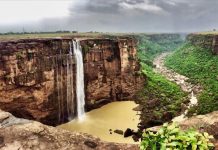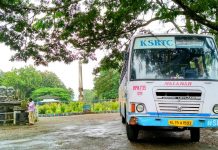A royal trip by Mammootty along the banks of Cauvery
Srirangapatna – the capital city of Tipu Sultan, who terrorized with his sword tip British Empire, where the sun never sets. The ancient scent in the air as one crosses the Fort gates. The kiss of the breeze on the cheeks during the coracle rides on the Cauvery. A trip along the historic Cauvery by actor Mammootty.
It is like a calendar photo that never fades even after scores of years. Behind a procession of soldiers dressed in dark colored attire marching rhythmically, drum beats and elephants adorned in gold, arrives the King on his chariot bearing the Royal flag. It is a procession of a long-lost glory the Mysore Dasara. Travelers from across the seas converge here to witness it.
The boundaries of the kingdom are evident even in the language of old people. During childhood, I have always heard about divisions and barriers. Though we belong to the former Kingdom of Cochin, I have always enjoyed the love and warmth of Ernad, Kadathanad, and Valluvanad. The magic of movies that breaks all barriers!
As I stood before the Mysore Palace, the happy shrieks of children from the buses crossing the Pass reverberated in my heart. It was my first long-distance trip during my schooldays. I still remember the yummy Mysore Pak I tasted that day. The first Mysore Pak was believed to be made in the kitchen of this Palace by a master chef of those times.
Mysore is the land of many precious treasures–sandal, silk, gardens, delicacies and sweet scents.
While preparing for the shoot of an advertisement of the South Indian Bank, I was thinking about coincidences. This ad film is also about a person’s travel through the amazing India, rich with various languages, attires, and customs. Director Sharat and his team were busy preparing for the shoot.
The city was slowly waking up from its deep slumber under the frozen blanket. Amidst the slowly growing traffic and noises stood the Mysore Palace, a grand structure built in decades – a beautiful amalgamation of Western, Hindu, and Islamic architecture. It is constructed using high-quality raw materials brought from all over the world. The dream-like wedding mandap, a spacious Durbar, and vast interiors lit up by glass roofs house the rare gifts and paintings received by the kings over the centuries. Photography is strictly prohibited there.
Even a lazy ride along the streets at dawn is fun; the cool breeze kisses the face as the bike surged ahead. In my mind’s frame appeared a dusty fight scene we shot for Thalapathy. A police action on the mob, a pregnant Selvi, portrayed by Geetha, being crushed in the stampede, a shocked Devarajan helplessly witnessing the death of his unborn child. I had been here for the shoot of the Mani Ratnam movie. Even after so many years, everything remains the same here.
Nature is beautiful like love. On the steps, people are paying tributes to their loved ones who left them. Children are playing on the old, ancient stone walls. Photo shoots by picnic groups. Beside all these, the lustrous Cauvery flows under the bright sun.
As I paddled the rotating coracle, life rewound to several years. I was reminded of Atharvam and the song “Puzhayorathu poothoniyetheela…”
It was while walking away from the coracle towards the shore I noticed a board which read “Swimming here is dangerous. Five persons had died here a few months ago. Strong undercurrents may turn fatal any moment.” I looked back at the calm river which flowed with unbelievable innocence.
Such days are very rare for me. I have always been someone who tries to swim against busy schedules and fails; a hapless soldier who fights time in vain.
Srirangapatna is also a battlefield. A real waterfront. The soil drenched in the blood of Bravehearts. The capital city of Tipu Sultan, who terrorized with his sword tip British Empire, where the sun never sets. The ancient scent in the air as one crosses the Fort gates. I remembered the words in a travel blog I stumbled upon while surfing. Srirangapatnamay does not sweep you off your feet with its views. But if you listen, you can hear the echoes of ages.
On returning from Chennai to Srirangapatna after the photo shoot of Pazhassi Raja, my thoughts were about Tipu and Pazhassi, two brave men who fought a war against Colonialism till death.
The spot where Tipu died during the Mysore War was a few kilometers away. History records his words “Should a King save himself by sacrificing the lives of his troops?” I would rather die like a tiger than life like a fox.
The British were terrorized. For them, Sultan was tiger who would charge at them any moment. Sultan loved the tiger; its majestic ferocity was, in fact, his reflection. Interiors decorated with miniature statues of bouncing tigers were a specialty of Srirangapatna’s architecture.
In the final war, when the British surrounded his Fort, Tipu cleverly retreated, but the Fort’s secret passage to the Cauvery was locked by traitors from within. Betrayal by those who were blinded by the wealth and positions they were offered. What pained him the most when he died might have been this heartless betrayal!
I was reminded of the scene in Pazhassi Raja in which the titular character was informed that Sultan has fallen. His death had deeply affected the struggles for independence.
Gumbaz is where Tipu is buried. It is the beautiful mausoleum Tipu had built for his father, Hyder Ali. His final resting place along with his trusted soldiers and loved ones.
Tipu’s Summer Palace, the prison where the British were held in captivity, the masjid and the ruins of a palace are all situated in a kilometer radius in this island.
The journey was nearing an end. As my bike sped along the dusty village roads, I saw pristine rural beauty, farmers with muddy bodies returning from their lands, women carrying bundles of grass on their heads and kids with curious eyes. I suddenly halted at a spiral path to a mountain to see a bright rainbow against the dark clouds. As I captured the scene on my mobile phone, darkness crept in.
On the return trip to Kozhikode, trying to focus on the passing city lights, I thought, When will I go on another such trip?
CLICK HERE TO READ IN MALAYALAM
The words we used while asking for directions during shooting trips along villages in Gundlupet and Mandya “Eshtu doora hoga beku?” rushed to my mind. (It means, how far is it…).
(Published in the 2009 September-October issue of Mathrubhumi Yathra)
(Translated by Vandana Mohandas)
(Photos by SL Anand)



















